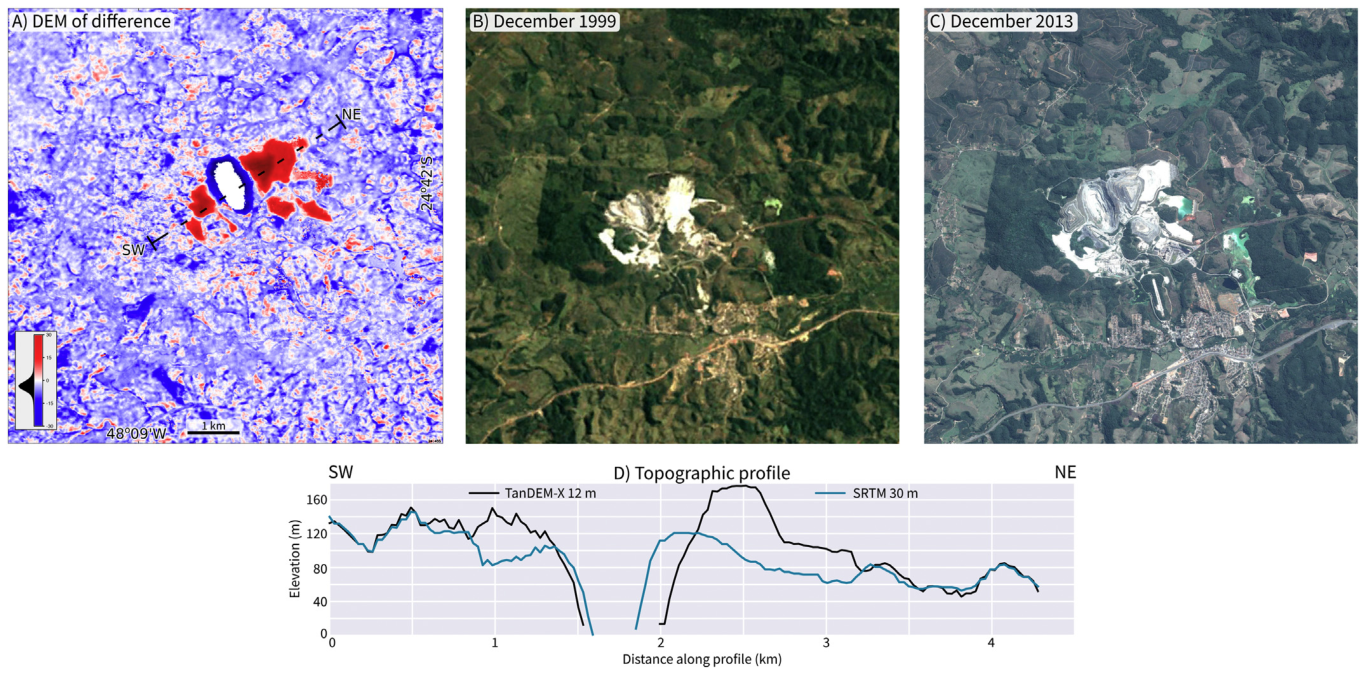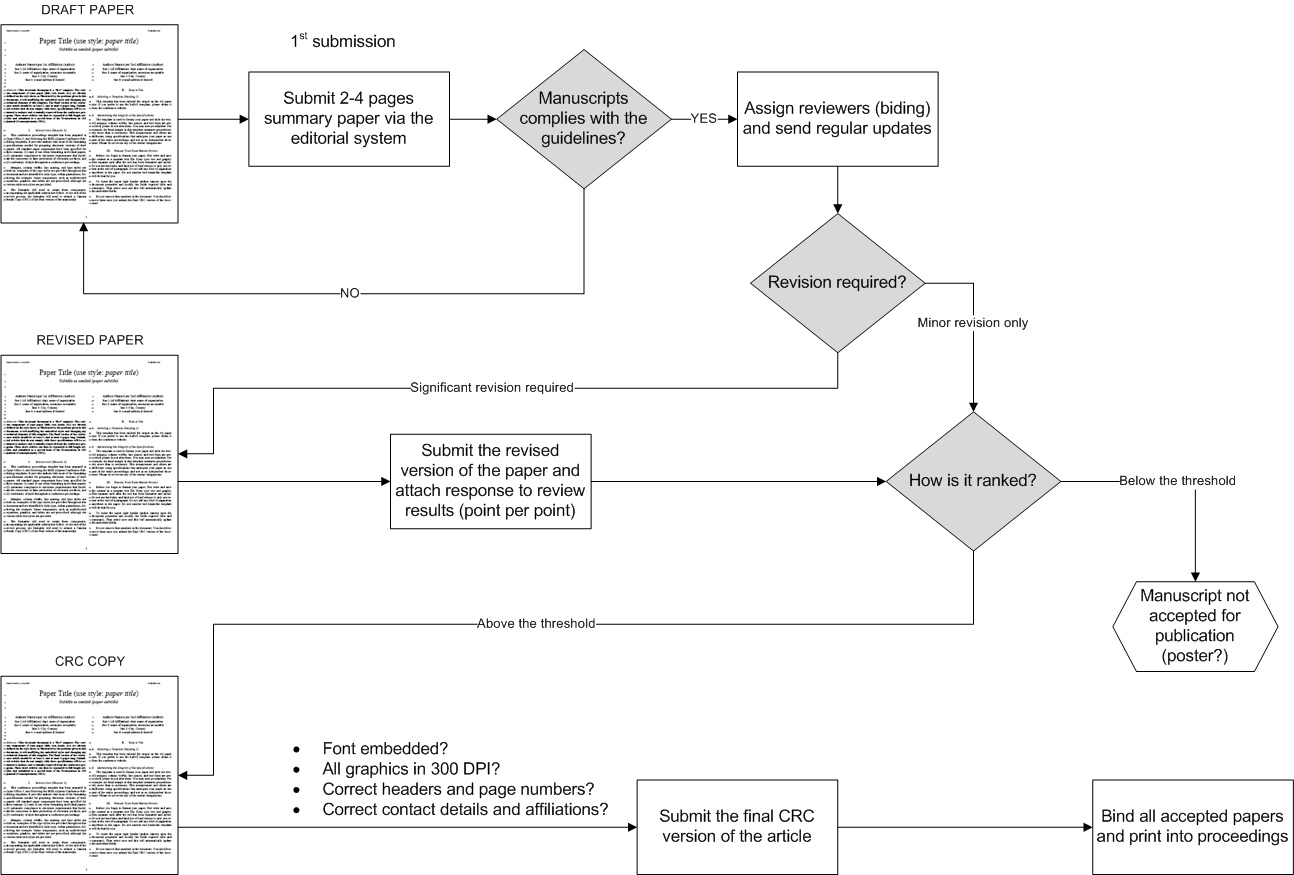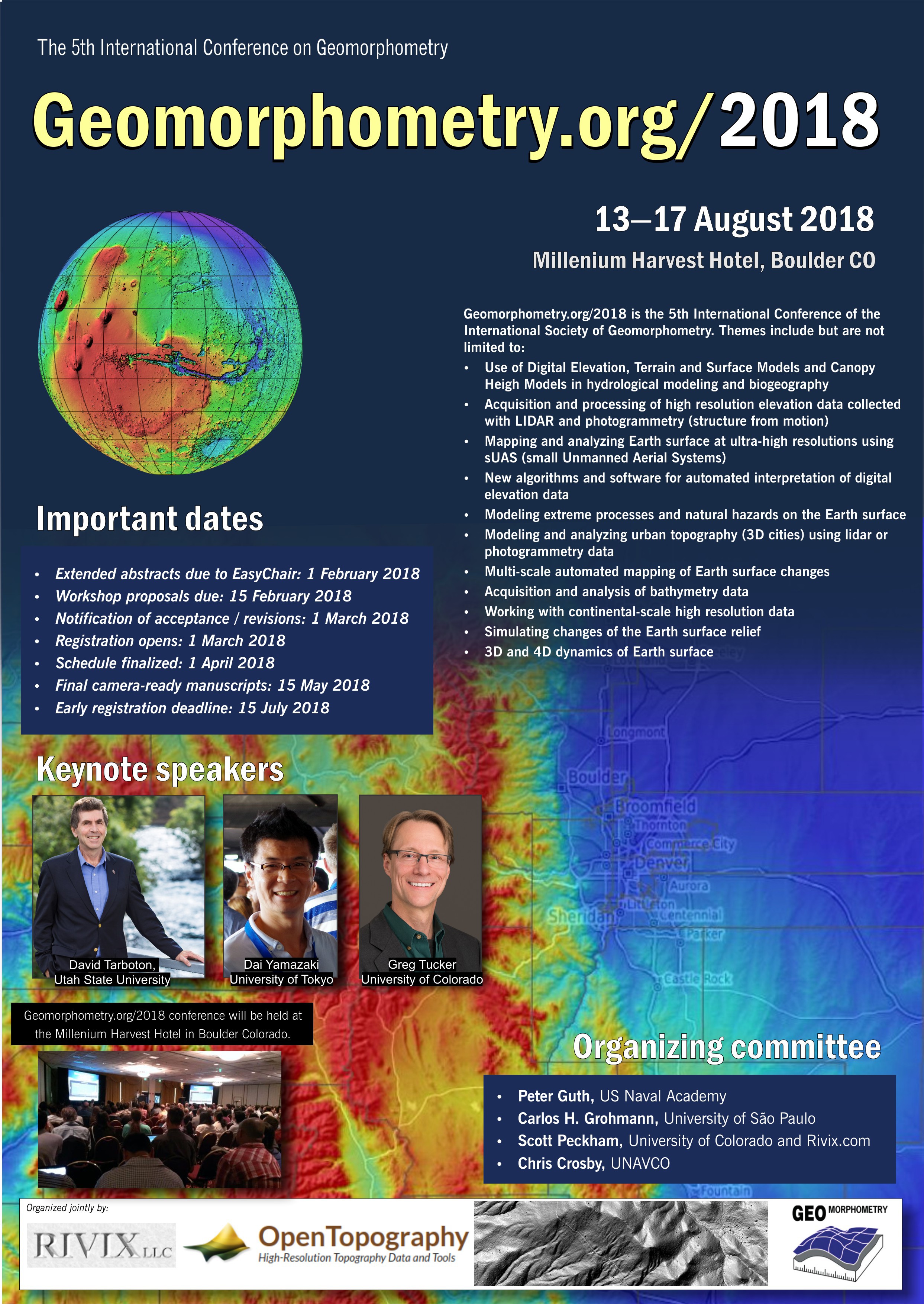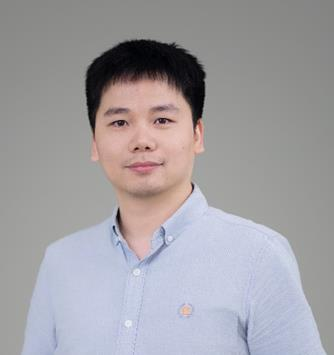Geomorphometry 2018 collection at PeerJ
Monday, August 13th
| 08:45-09:00 | Session 1: Conference Welcome |
| 09:00-10:00 | Session 2: Keynote by David Tarboton, Utah State: Web Based Hydrologic Terrain Analysis through HydroShare |
| 10:00-11:40 | Session 3A: Stream Networks |
| 10:00-10:20 | Giuseppe Amatulli, Sami Domisch, Jens Kiesel, Tushar Sethi, Dai Yamazaki and Peter Raymond. High-resolution stream network delineation using digital elevation models: assessing the spatial accuracy |
| 10:20-10:40 | Scott D. Peckham. Using the Open-source TopoFlow Python Package for Extracting D8-based Grids from DEMs and for Fluvial Landscape Evolution Modeling |
| 10:40-11:00 | Qiming Zhou, Fangli Zhang and Liang Cheng. A Data-driven Method for the Determination of Water-flow Velocity in Watershed Modelling |
| 11:00-11:20 | Shangmin Zhao, Shifang Zhang and Weiming Cheng. Hydrologic application comparison among typical open global DEM data based on remote sensing images |
| 11:20-11:40 | Richard Barnes. RichDEM: High-Performance Terrain Analysis |
| 10:00-17:00 | Session 3B: Posters |
| 10:00-17:00 | Zhang Jin. Slope Ranking and geohazards correlation analysis for Combined Open-Underground Mining area |
| 10:00-17:00 | Xiaoli Huang and Liyang Xiong. Space-for-time substitution and the evolution of gully system in a small watershed of the Chinese Loess Plateau |
| 10:00-17:00 | Jiaming Na and Guoan Tang. Simulation on the Evolution of Loess Gullies and Landforms Based on Archaeological Remains Information |
| 10:00-17:00 | Jilong Li, Guoan Tang, Fayuan Li and Jianjun Cao. Delimitation of the transition zone between active and inactive gully erosion in the Chinese Loess Plateau |
| 11:40-12:40 | Lunch |
| 12:40-13:30 | Session 4: Highlight Paper |
| 12:40-13:00 | John Wilson. Geomorphometry: Today and Tomorrow |
| 13:10-14:50 | Session 5: Data resolution and scale |
| 13:10-13:30 | Samantha Arundel, Wenwen Li and Xiran Zhou. The Effect of Resolution on Terrain Feature Extraction |
| 13:30-13:50 | Massimiliano Alvioli, Alessandro Cesare Mondini, Federica Fiorucci, Mauro Cardinali and Ivan Marchesini. Automatic landslide mapping from satellite imagery with a topography-driven thresholding algorithm |
| 13:50-14:10 | Flavius Sirbu, Lucian Dragut, Takashi Oguchi, Yuichi Hayakawa and Mihai Micu. Sensitivity of land-surface variables to scale in identifying landslide scarps |
| 14:10-14:30 | Adnane Habib, Kourosh Khoshelham, Nadia Akdim, Fatima-Ezzahra El Ghandour, Kamal Labbassi and Massimo Menenti. Enhancing DEMs for geomorphometric research through digital filtering |
| 14:30-14:50 | Peter Guth. What Should a Digital Terrain Model (DTM) Portray? |
| 14:50-15:10 | Break |
| 15:10-16:10 | Session 6: Planetary geomorphometry |
| 15:10-15:30 | Weiming Cheng. A preliminary study of classification method on lunar topography and landforms |
| 15:30-15:50 | Yan-Wen Wang, Cheng-Zhi Qin, Wei-Ming Cheng and A-Xing Zhu. Detecting craters by training random forest based on existing crater map and spatial structural information |
| 15:50-16:10 | Tao Liu and Victor Baker. Hydraulic Modeling of Megaflooding Using Terrestrial and Martian DEMs |
| 16:10-17:10 | Session 7: Discussion on non-profit status |
Tuesday, August 14th
| 09:00-16:00 | Field trip |
Wednesday, August 15th
| 09:00-10:00 | Session 8: Keynote by Dai Yamazaki, The University of Tokyo: MERIT DEM: a high-accuracy global elevation map by multi-component error removal |
|
| 10:00-11:40 | Session 9: Classification of topography | |
| 10:00-10:20 | Jozef Minár, Peter Bandura, Lucian Drăguţ, Ian Evans, Michal Gallay, Jaroslav Hofierka, Juraj Holec, Ján Kaňuk and Anton Popov. Physically-based land surface segmentation: Theoretical background and outline of interpretations |
|
| 10:20-10:40 | Massimiliano Alvioli, Ivan Marchesini and Fausto Guzzetti. Nation-wide, general-purpose delineation of geomorphological slope units in Italy |
|
| 10:40-11:00 | Ovidiu Csillik and Lucian Dragut. Towards a global geomorphometric atlas using Google Earth Engine |
|
| 11:00-11:20 | Peter Bandura, Jozef Minár, Lucian Dragut and Miroslav Bielik. Physically-based segmentation of the Western Carpathians (Central Europe) |
|
| 11:20-11:40 | Junko Iwahashi, Takayuki Nakano and Dai Yamazaki. Classification of topography in artificially modified alluvial plains using DEMs |
|
| 11:40-12:40 | Lunch | |
| 12:40-13:30 | Session 10: Highlight Paper | |
| 12:40-13:00 | Vincent Lecours, Vanessa Lucieer, Margaret Dolan and Aaron Micallef. Recent and Future Trends in Marine Geomorphometry |
|
| 13:00-14:20 | Session 11: Accuracy and Error Propagation | |
| 13:00-13:20 | Mehran Ghandehari and Barbara P. Buttenfield. Slope-Adjusted Surface Area Computations and Error Propagation in Digital Terrain |
|
| 13:20-13:40 | Christopher Wecklich, Carolina Gonzalez and Paola Rizzoli. Height Accuracy and Data Coverage for the Final Global TanDEM-X DEM Data |
|
| 13:40-14:00 | Peter Bandura and Michal Gallay. Validation of TanDEM-X elevation data for a forested karst area in Slovakia (Central Europe) |
|
| 14:00-14:20 | Mihai Niculita. Assessing the accuracy of SRTM altitude data for the hilly area in northeastern Romania |
|
| 14:30-14:50 | Break | |
| 14:50-16:10 | Session 12: Glacial and Marine Geomorphometry | |
| 14:50-15:10 | Mihai Niculita and Ian Evans. Effects of glaciation on the clinometry and hypsometry of the Romanian Carpathians |
|
| 15:10-15:30 | Da Huo, Michael Bishop and Brennan Young. Geomorphometric assessment of glacier state in the Karakoram, Himalaya |
|
| 15:30-15:50 | Kwanmok Kim, Vincent Lecours and Peter C. Frederick. Using 3D Micro-Geomorphometry to Quantify Interstitial Spaces of an Oyster Cluster |
|
| 15:50-16:10 | Nathalie Debese, Jean-José Jacq, Koen Degrendele and Marc Roche. Toward Reliable Volumetric Monitoring of Sandbanks |
|
| 16:10-17:10 | **Session 13: Roundtable | ** |
Thursday, August 16th
| 09:00-10:00 | Session 14: Keynote by Greg Tucker, University of Colorado: Lidar meets Landlab: using digital topography to test and calibrate long-term erosion models |
| 10:00-11:40 | Session 15: DEM surfaces, lidar, and radar |
| 10:00-10:20 | Marián Jenčo. Detection of Degenerate Points on the Surface |
| 10:20-10:40 | John Lindsay and Daniel Newman. Hyper-scale analysis of surface roughness |
| 10:40-11:00 | Qiaomei Su, Chenyu Wang, Shangmin Zhao and Jianmin Wang. Study on fractal dimension of spatial distribution patterns for hidden danger points of geological hazards: taking Huoxi Coalfield of China as an example |
| 11:00-11:20 | Francis Rengers and Luke McGuire. Quantifying Hillslope Erosion with Lidar |
| 11:20-11:40 | Nicusor Necula, Mihai Niculita and Mario Floris. Using Sentinel-1 SAR data to detect earth surface changes related to neotectonics in the Focșani basin (Eastern Romania) |
| 11:40-12:40 | Lunch |
| 12:40-13:30 | Session 16: Highlight Paper |
| 12:40-13:00 | Hannes Isaak Reuter. Geomorphometry – 10 years after the book – challenges ahead ? |
| 13:10-14:30 | Session 17: UAV/SfM I |
| 13:10-13:30 | Igor Florinsky, Dmitrii Bliakharskii, Sergey Popov and Sergey Pryakhin. The 2017 Catastrophic Subsidence in the Dålk Glacier: Unmanned Aerial Survey and Digital Terrain Analysis |
| 13:30-13:50 | Michal Gallay, Ján Šašak, Ján Kaňuk, Jozef Šupinský, Jaroslav Hofierka and Jozef Minár. High-resolution digital terrain modelling of a rugged alpine terrain by fusing data from terrestrial laser scanning and UAV photogrammetry |
| 13:50-14:10 | Carlos Grohmann, Camila Viana, Mariana Busarello and Guilherme Garcia. Structural analysis of clastic dikes based on Structure from Motion/Multi-View Stereo |
| 14:10-14:30 | Marek Kasprzak and Mariusz Szymanowski. Terrain determinants of permafrost active layer thermal conditions: a case study from Arctic non-glaciated catchment (Bratteggdalen, SW Spitsbergen) |
| 14:30-14:50 | Break |
| 14:50-15:30 | Session 18: UAV/SfM II |
| 14:50-15:10 | Alberto Alfonso-Torreño, Álvaro Gómez-Gutiérrez, Susanne Schnabel, José Juan de Sanjosé Blasco and Manuel Sánchez Fernández. Quantifying sediment volume retained in hydrological correction check dams by means of high-resolution DEMs in a semiarid rangeland of SW Spain |
| 15:10-15:30 | Álvaro Gómez-Gutiérrez, Trent Biggs, Napoleon Gudino Elizondo, Paz Errea, Esteban Alonso Gonzalez, Estela Nadal Romero and José Juan de Sanjosé Blasco. Elaborating more accurate high-resolution DEMs using SfM workflow |
| 15:30-15:50 | Session 19: Recent ESRI enhancements in geomorphometry |
| 15:50-16:50 | Session 20: Elections, Awards, and Geomorphometry 2020 |
Friday, August 17th
| 09:00-12:00 | Workshop 21A: Using GDAL and PKTOOLS for Raster Operations |
| 09:00-12:00 | Workshop 21B: Processing Large Rasters using Tiling and Parallelization: An R + SAGA GIS + GRASS GIS Tutorial |
| 09:00-12:00 | Workshop 21C: A Hands-On Introduction to RiverTools 4.0 |
| 09:00-12:00 | Workshop 21D: Google Earth Engine for large-scale DEM analysis |
| 12:00-13:00 | Lunch for Workshop participants |
| 13:00-16:00 | Workshop 22A: Using GDAL and PKTOOLS for Raster Operations Part 2 |
| 13:00-16:00 | Workshop 22B: Processing Large Rasters using Tiling and Parallelization: An R + SAGA GIS + GRASS GIS Tutorial |
| 13:00-16:00 | Workshop 21D: A Hands-On Introduction to RiverTools 4.0 |
| 13:00-16:00 | Workshop 22D: Google Earth Engine for large-scale DEM analysis |
 Difference between TDX and SRTM for a mining area in southeastern Brazil
Difference between TDX and SRTM for a mining area in southeastern Brazil

